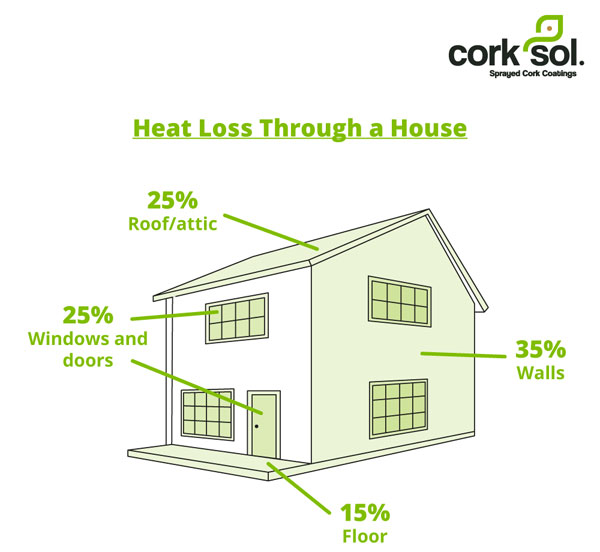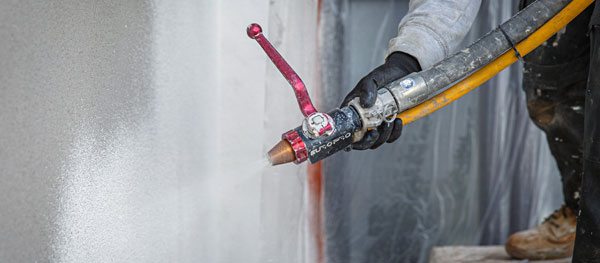The Poor State of Insulation
Britain has an existing housing stock that is the oldest in Europe. And this means that many properties don’t have any insulation – in fact, only about 50% have cavity or solid wall insulation.
 Heat loss in a house happens faster in poorly insulated homes. So with no insulation, the existing stock of houses aren’t as energy efficient as they could, and should, be.
Heat loss in a house happens faster in poorly insulated homes. So with no insulation, the existing stock of houses aren’t as energy efficient as they could, and should, be.
It’s generally considered that about 35% of heat lost is through the walls, and 25% is through the roof. The lack of insulation means that cold, external walls are the chief culprit for heat loss because, without adequate insulation, they don’t keep heat inside the home, which makes it harder to maintain a comfortable temperature and causes energy bills to rise as thermostats are turned up higher and are left on for longer. And with the majority of heating systems being reliant upon fossil fuels, not only do energy bills increase but the impact on the planet is also significant.
There is also a second problem that arises from this with the formation of condensation on cold surfaces, which can lead to problems with damp and mould. According to The English Housing Survey for Housing Quality and Condition(1), 3.5 million occupied homes were not suitable and did not meet the Decent Homes Standard in 2020, with 4% having serious damp issues. In turn, this poses problems for your health, including respiratory infections, allergies, asthma, immune system issues and Long Covid related illnesses. In the social housing sector, this places the onus on landlords and housing associations to provide safe housing for their tenants.

The Size of the Problem
Whilst new houses are being built to improved standards, there are an existing 25 million UK dwellings which are still potentially extremely energy inefficient– and it is reported that by 2050, 80% of these will still be in use. This will account for 99% of the overall housing stock.
So it is important to retrofit the existing housing stock to ensure they are able to provide comfortable, healthy homes. And this will come at a significant cost. Some housing associations are already planning major retrofit programmes for their existing house stock as they see the long-term benefits to their tenants and to the planet.
What are the Options?
There are a number of ways to insulate cold walls which can eliminate the issues outlined above. These can be internally or externally applied and include cavity wall insulation, external wall insulation, and internal wall boards. However, each of these solutions isn’t without its own issues, such as a lack of cavity, or small rooms which internal insulation boards will only make smaller.
To ensure the existing housing stock is able to provide suitable habitation for the years to come, it is essential to retrofit with effective and long-lasting insulation that will help to improve the energy efficiency of the property and reduce potential health risks for the inhabitants.

SprayCork, from CorkSol UK, is a sustainable and eco-friendly sprayed cork coating for walls and ceilings which reduces heat loss though walls and helps to eliminate mould and condensation. The advantages of applying SprayCork is that it can be applied internally or externally and helps to retain heat by trapping the warm air in the room which makes heating the house much more affordable. And because SprayCork is a completely breathable material, it is resistant to moisture and therefore eliminates damp and mould.
The unique honeycomb structure of cork comprises countless pockets of air within the material itself. This gives it a long list of natural qualities, including durability, flexibility, sound insulation and thermal insulation.
And research has been done to back this up. When used as an internal wall coating, a sprayed cork solution has been proven to reduce heat loss through solid walls by 30%(2), which is a significant amount of heat staying within the property.
The Race to Decarbonise
With the current climate crisis, it is important to consider ways to become carbon neutral. Of the UK’s total carbon dioxide emissions, about 15% is from existing housing, which mainly comes from the gas boilers heating them. Glaringly, therefore, there is a huge need to significantly reduce their CO2 emissions. The thermal properties of cork reduce the requirements on heating systems, which are still predominately powered by fossil fuels. But another key advantage of cork is the sustainable way it is harvested and the regeneration process where the absorption CO2 significantly increases.
(1) https://assets.publishing.service.gov.uk/government/uploads/system/uploads/attachment_data/file/1088447/EHS_Housing_quality_and_condition_report_2020.pdf
(2) https://corksoluk.com/latest-news/corksol-is-proven-as-the-leading-thin-internal-wall-insulation-solution-case-study/
- Log in to post comments













